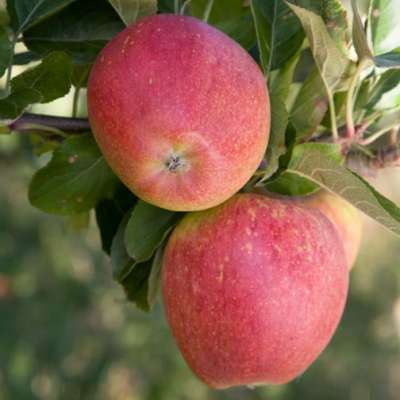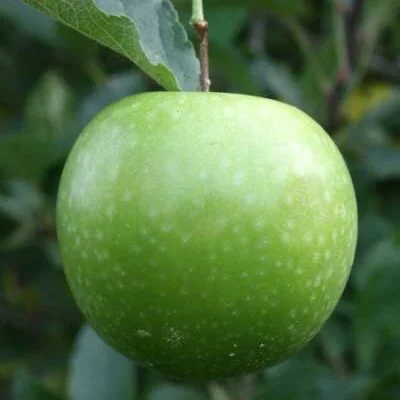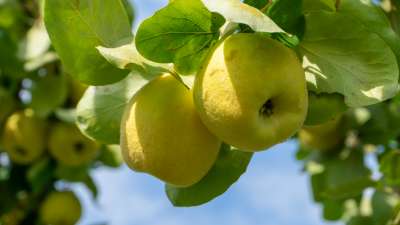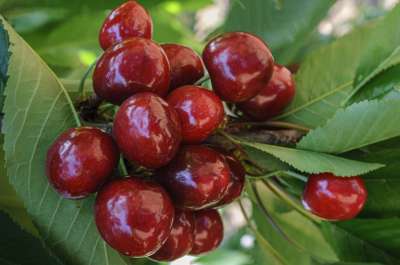Your basket is currently empty!
So many of us seem to have a spare North wall which goes unloved and remains largely unproductive. Maybe it is home to a straggly black-spot riddled rose or an unhappy and unsuited wisteria that never flowers. North walls have a reputation for being useless especially when it comes to growing fruit trees but this needn’t be the case – although the selection of varieties that will yield reliably there may be more limited its certainly no lost cause. But you need to be selective in what you plant to ensure the best results and a certain amount of compromise may be necessary over what may have been your initial wish-list.
You can purchase our quality fruit trees here
It should also be noted that North walls can have some advantages too – sunny south or west facing aspects can get seriously dry during hot weather especially as many walls – or fences – are largely sheltered from prevailing rains. This isn’t an issue so much with North walls which tend to remain damp at soil level – and the temperature too is more even and equable.
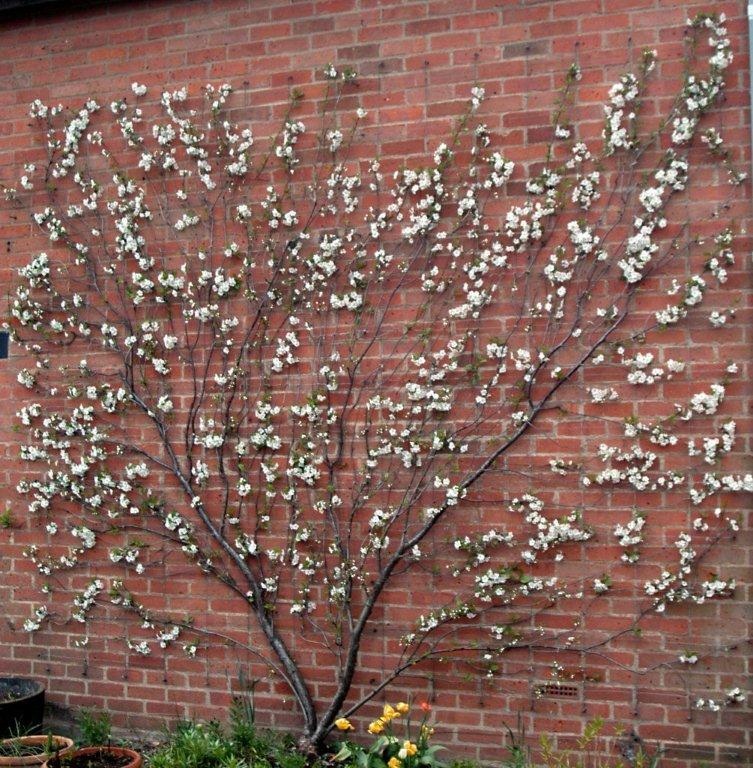
As a general rule of principle ensure before embarking on your project that the wall has a good 24” of useful top soil; so often when one starts to plant against walls new or old you find that immediately beneath what at first appears to be promising soil you hit rubble or a pan of solid grit. Advance preparation of a hole large enough to take the roots and back filled with good compost will ensure your in a good position to get your new trees off to a promising start.
Spacing
The first question you may ask is exactly how much room do you need for your new tree[s] There are two main growing forms for wall training – the fan or espalier and the cordon. Cordon trained trees tends to be reserved for apples and pears and sometimes plums too but is not a useful method for cherries. Cordon fruit trees need much less space as the side branches are kept pruned back to just a few inches so you can space these trees just 30” apart or so. They are quite simple to prune and whilst in days gone bay they were traditionally grown at a 45 degree angle [because it was believed it resulted in better growth] these days they are more likely to be grown upright. If the iea of growing them on the slant pleases you then you can still plant them at ant angle but of course it will take up more room. Cordon trees can be controlled to 6-7 in height.
The fan or espalier tree – both a traditional flat’ shaped trees for a wall – remainsz a hugely popular choice for garden growing but the pruning method and upkeep is a little more complicated and the trees will take up much more room than a cordon tree. Allow not less than 180cm’s for a fan or espalier tree. The height of such trees is normally about the same. Espalier growing is reserved only for apple and pear but fan trees can be utilized for apple pear plum & cherry too.
Cordon trees can often be grown self supporting against a wall as they will gn sufficient protection from wind and the main stem will be pretty strong; fan or espalier will need a succession of straining wires [rubber coated] at 24” intervals up the wall along which you will tie the lateral growths.
When should you plant fruit trees against a North wall? Well another advantage of this seemingly unpromising situation is that summer planting is easier as the trees wont’ be under so much stress in the cool shade of the day and less watering will be involved. So really bare root stock planted during winter and container grown trees from late Spring through Autumn will ensure year round planting is successful.
Choice of Varieties
Now comes the exciting part – what to grow…..
Apples
Some apple varieties demand a degree of warmth and sunshine to ripen properly that is not offered by a North wall; but there are severa that do not demand such luxuries and will offer good fruits with a certain amount of shade. Many of them fall into the cooking and culinary categories so the home cook that enjoys using cooking apples in the kitchen will be well served. Cooking varieties as a hole are actually hardier than dessert varieties and any that fall within that category you can consider and use. But I will offer you a list of eating apples too which you can plant on your North wall.
ARTHUR TURNER Apple Tree Is a grand old Scottish cooker that is renowned for it’s frost resistant blossoms, the largeish fruits excel for baking and are ready for use in September. The blossom is attractive too.
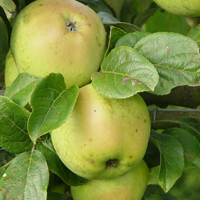
BOUNTIFUL APPLE TREES This relatively new cooking variety is super-reliable and has the added value that it stores late. It is a sweet tasting cooker that can often be eaten without sugar, infact it can be used as an eater late in the Spring. Easy to pollinate & productive.
LORD DERBY APPLE TREES Large handsome shiny fruits with a pure white flesh and a mild semi-sweet taste. An old campaigner which is tough hardy and late flowering so tends to avoid frost damage. Suits all cooking applications.
SCOTCH BRIDGET APPLE TREES A fine sub-acid flavour, the fruits of this culinary speciality develop a pinkish blush. Heavy cropping and always reliable.
HOWGATE WONDER APPLE TREE I really like this variety for it’s mightily impressive, huge fruits and lovely taste. Ripening in November and suitable for use until the new year. Stews really well and makes a classic apple pie too.
JAMES GRIEVE APPLE TREE Another Scottish raised variety and one of the really popular garden apples which suits that shady wal really well. Doubles as a dessert and cooker with a fine semi-sharp flavour. Season September-October.
IDARED APPLE TREE Although an early flowerer, has a good degree of frost hardiness to the blossoms and the striking deep red flush develops even in the shade. The inner flesh is quite solid and white and it cooks well initially, but well ripened fruits are often used for dessert. It stores and stores, well into Spring, with ease.
RED FALSTAFF APPLE TREE A true eating apple that survives significant frost and still sets fruit. An apple in the Braeburn style [but a lot more prolific than that variety] with a crisp juicy texture, the fruits ripen in October and will store. [self fertile]
REDSLEEVES APPLE TREE Redsleeves is one of the hardiest of all apple varieties and seems to do well everywhere, it also has mildew and scab resistance which is a useful attribute to have when you’re growing in shade. An early snall jolly red apple that is sweet and more-ish.
GREENSLEEVES APPLE TREE Compatriot to Redsleeves, this lovely fresh pale green apple with it’s semi sweet dessert taste, crisp texture and plenty of juice makes for an enjoyable eating experience. It is later ripening than Redsleeves and will keep for a few weeks, and I have seen trees perform well in shady positions. [self fertile]
JUPITER APPLE TREE This is a Cox-type apple, but thankfully a mnuch better grower. Being a triploid it is quite strong and tends to get little disease, which is an important consideration when comparing trees for a shady wall where mildew and other fungal diseases can be more prevalent. Jupiter has a wonderful rich aromatic taste and ripens mid October. Will keep for several weeks. This variety does not ample pollinating partners to give of it’s best.
Cherries
For a start, forget about the idea of growing a sweet cherry on a North wall – it simply won’t work. Fresh eating cherries like warmth and sun, so only consider these for a favourable south or west facing aspect. However cooking cherries are the most renowned and satisfactory of all fruit trees for just such a position. Sometimes cooking cherries are dismissed somewhat out of hand but let me extol the virtues of having your own supply of mouthwatering cherries that are ideal for fresh baked cherry pie, jams and preserves, juicing and freezing. You can never, ever, buy true cooking cherries in the shops, and they yield prolifically on a hardy little tree. These varieties are self fertile too.
It will be easier to net against birds [which will take cherries, before they are even properly ripe] although it has to be said that the cooking types are less likely to be eaten than the sweet.
MORELLO CHERRY TREES is the first and foremost variety that most people know and remains the most oft-planted. The fruits ripen all over the tree in July and it can display surprisingly good Autumn foliage colour too.
NABELLA CHERRY TREES is a newer variety with improved performance characteristics – yet it hasn’t really caught on in the popularity stakes but is one well worth a try.
Pears
Pears trees are less suited to shady walls than Apples but if you really yearn for a Pear tree and there’s nowhere else to go then a couple of varieties should perform satisfactorily. Pears can be grown as fan, espalier or cordon.
INVINCIBLE PEAR TREES is the first of these and it’s certainly Invincible in name and nature. The flowers open in succession so if the first opening blooms get frosted there’s more to follow which is what makes it so reliable. The tree is tough and hardy and it’s self fertile too. The fruits are quite crisp and have a pleasant, mellow flavour. October eating.
CANNOCK PEAR TREES A Midlands variety that’s used to poor temperatures and a bit of shade; it is a dual purpose cooking and eating variety – even Perry making too, making it an interesting consideration.
CATILLAC PEAR TREES Is a true cooking variety and it’s a triploid too, which makes it a vigorous hardy grower. The fruits are truly ‘pear shaped’ quite weighty and should be left on the tree as long as possible; you can then pick them and ripen further in storage – they keep for quite some time. Cooking pears suit pies, tarts, baking, slicing and freezing and will keep their shape better than dessert pears used for the same purpose, and develop a perfect flavour when cooked with.
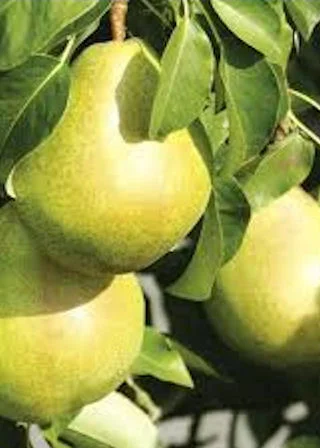
Damsons
These tough little fruit trees do well in colder climates and are synonymous with a lot of Northern orchards. I have a tree well overshadowed with shade that still crops well and the Shropshire Damson, Farleigh, or Merryweather, all make surprising but valuable choices for fan training on a North wall. The fruits won’t ripen till late so leave them as long as possible. The taste is powerful and quite tart, only used for cooking purposes but jams and pies made from Damsons are out of this world. All varieties mentioned are self pollinating.
Greengages
Greengrages are not suited to North wall as they like too much sun and warmth. Only consider them for South or West facing aspects. Dennistons Superb might cope on a less promising wall and may be worth trying.
Plums
A lot of Plum varieties simply aren’t worth considering for this type of situation but some that will cope and prove useful.
JUBILEE PLUM TREE hails from Sweden so is used to cooler temperatures and frost and is the most reliable Plum you can grow. Ripening mid-late August it suites dessert and cooking, and it is self fertile too. Violeta comes from the same place and is earlier – often ready for picking by late July. The oval deep violet fruits are of dessert quality and taste.
CZAR PLUM TREE is more of a cooking variety but can be enjoyed fresh too when properlyt ripe. It is renowned for it’s hardy durability and it is self fertile too. Earlier than Jubilee, ready from late July.
BURBANKS GIANT PRUNE Often considered the toughest of all Plums, this old orchard survivor will take to your North wall and provide weighty oval deep purple-red fruits in September. They are more used for cooking purposes than eating fresh. Self fertile.
Marjories Seedling and Purple Pershore are also suitable considerations.
Remember that fruits from a shady wall may be a little later ripening than you might expect, in all cases.
That’s it folks. I hope you will now re-appraise your North wall and are now inspired with enthusiasm for it is possible to turn it into a propductive – and attractive – space.
Don’t forget you can underplant with ferns, pulmonaria, hellebores, violets and other smaller shade loving plants.
There are soft fruits that can enjoy life on the shady side too – most notably Blackberries and their near relatives the Tayberry. You will need to allow about 180cm’s plus in width for a single Blackberry, Tayberry or Hybrid Berry. All varieties are suitable, Oregon Thornless, Bedford Giant and Merton Thornless get my vote. And Japanese Wineberries, such an ornamental delight with those fuzzy vermillion stems and orange red berries, is also able to grow well on North and East facing walls.
Gooseberries too can do well – opt for mildew resistant varieties and grow them as cordons, for which a spacing of 20” or so should be adequate. Look at varieties such as Invicta, Greenfinch, Rokula and Marlet as well as Whinhams Industry.
Select from our soft fruits and bushes large range.



